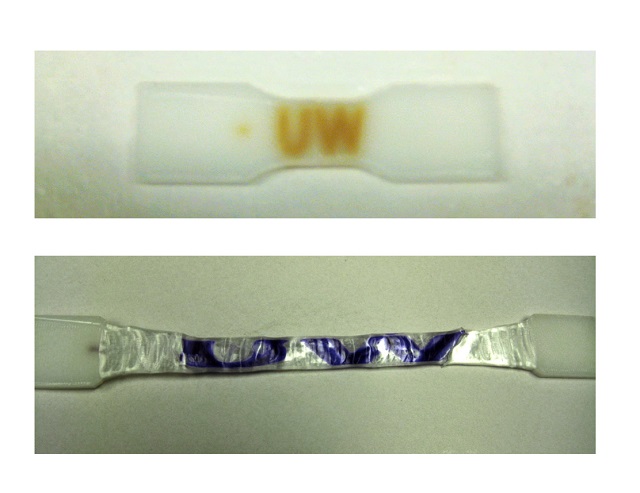 The top panel is a 3D printed plastic tab with the letters “UW” printed in a slightly different material. The bottom panel is the same material after stretching.
The top panel is a 3D printed plastic tab with the letters “UW” printed in a slightly different material. The bottom panel is the same material after stretching.
Researchers at the University of Washington (UW) have developed a bone-shaped plastic tab that turns purple when stretched. The invention is a combination of custom chemistry and 3D printing, enabling the scientists to easily record the force of an object.
At the UW, this is a marriage that’s been waiting to happen – 3D printing from the engineering side, and functional materials from the chemistry side.
Andrew J. Boydston, a UW assistant professor of chemistry
The doctoral students in chemistry at UW, Gregory Peterson and Michael Larsen, developed a polymer or a plastic formed of different units linked together and placed into the commercial 3D printer at the chemistry lab.
One print head of the 3D printer contained polycaprolactone, which is similar to the flexible filament sold by 3D printer companies. While the other print head contained a plastic that is 99.5 percent identical, however the UW scientists induced certain insertions such as spiropyran molecule which changes the color of the material when stretched.
We wanted to demonstrate that the functional chemistry could be incorporated readily into already printable materials. We found that designer chemistry can be incorporated into 3D printing very rapidly.
Andrew J. Boydston, a UW assistant professor of chemistry
The printed tab is a white plastic piece with visible stripes that turn purple with an application of force. It serves as a cost-effective mechanical sensor without electronic components. It took nearly 15mins to print the whole device using materials that cost nothing more than a dollar.
The sensor can be used to record the value of force or strain on any building or structure. Boydston is keen on developing a sensor that records the speed of impact or the force on a object such as a football helmet that changes its color upon being hit by a force.
The project is a result of collaboration between UW mechanical engineers and co-authors Mark Ganter and Duane Storti, and Boydston’s group who were involved in new 3D printing materials and techniques.
The machine can be programmed with different instructions to print the plastics in any configuration, such as having the color changing section present in the stripes in the middle, completely enclosed in another plastic or in any other specific shape.
Boydston, a specialist in organic synthesis said, “It means making more complex molecules from simpler, more available ones.” The process of changing the way the plastic is made could generate molecules, which respond in different ways.
Maybe the material isn’t currently under stress, but it had been several times prior to your observing it. And so these types of materials could record that load history.
Andrew J. Boydston, a UW assistant professor of chemistry
Boydston claimed that he will continue to work on the development of more 3D printed objects incorporated with designer molecules, in collaboration with Ganter and Storti. He explained that the 3D printing technology creates new opportunities’ for individualized medical implants or other custom materials with engineered molecules responding to the environment.
.jpg)
The researchers put slightly different plastics in each of the printer’s two print heads. One of the plastics changes color when it is stretched.A.J. Boydston / UW
“This is definitely an area that we want to continue to expand into,” Boydston said.
The research was published in the American Chemical Society’s journal of Applied Materials and Interfaces, and it was funded by the University of Washington.
References